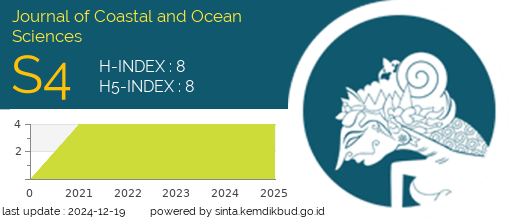Bivalve Abundance and Distribution in the Seaweed Ecosystem in the Waters of Jago-Jago Village, Tapanuli Tengah, North Sumatra Province
DOI:
https://doi.org/10.31258/jocos.5.2.135-142Keywords:
Jago-Jago, Distribution, Abundance, BivalvesAbstract
This research was conducted in May 2022. This research was conducted in Jago-jago Village, Tapanuli Tengah, North Sumatra Province. The aim was to determine the abundance and distribution pattern of bivalves in the study area. The method used in this study is a survey method, namely direct observation, taking samples in the field, and then analyzing them in the laboratory. Determining observation stations and data collection using the purposive sampling method is done by considering various conditions at the research location. Sampling was carried out at three stations that were considered representative of the research area. Each station consists of 3 transects with a length of 50 m each, where each transect has three plots measuring 1x1m2. From the research results of the types of bivalves found in the coastal waters of Jago-Jago Village during the study, there were six types of families, namely Arcidae, Cardiidae, Mesodesmatidae, Ostreidae, Donacidae, and Corbiculidae. At the same time, there were as many as six species: Anadara antiquata, Trachycardium subrugosum, Atactodea sp, Crassostrea sp, Donax sp, and Polymesoda erosa. Based on the results of the ANOVA test, it was known that the abundance of bivalves in the coastal waters of Jago-Jago Village showed a significant value obtained <0.05, namely 0.016. This indicates that the difference in abundance between stations is significantly different. The average organic matter content at station 1 is 4.59%. The substrate is muddy sand with an abundance value of 4.33 ind/m2. At station 2, the organic matter content is 4.05% with sand substrate, and the abundance value is 3.11 ind/m2. The organic matter content at station 3 is a 6.39% sandy mud substrate with an abundance value of 6.11 ind/m2. The highest relative abundance of bivalves found at station 3 was Donax sp, which is 32.72%.
Downloads
References
Alfiansyah, A. (2014). Struktur Komunitas Bivalvia pada Kawasan Padang Lamun di Perairan Teluk Dalam. Jurusan Ilmu Kelautan: FIKP UMRAH.
Clark, J., & Deswarte, F. (2008). Introduction to Chemical from Biomass. John Wiley and Sons. United Kingdom
Dahuri, R. (2003). Keanekaragaman Hayati Laut Aset Pembangunan Berkelanjutan Indonesia. Gramedia Pustaka Utama. Jakarta.
David, L.B. (2011). Inventarisasi Lamun di Perairan Desa Jago-Jago Kecamatan Badiri Kabupaten Tapanuli Tengah Provinsi Sumatera Utara. Fakultas Perikanan dan Kelautan. Universitas Riau. Pekanbaru.
Dewiyanti, I. (2004). Struktur Komunitas Moluska (Gastropoda dan Bivalvia) serta Asosiasinya pada Ekosistem Mangrove di Kawasan pantai Ulee-Lheue Banda Aceh NAD. Program Studi Ilmu Kelautan Departemen Ilmu dan Teknologi Kelautan. Fakultas Perikanan dan Kelautan. Institut Pertanian Bogor. Bogor.
Dhewani, N., & Kusumawati, P. (2009). Pemantauan Perikanan Berbasis Masyarakat (CREEL) di Kabupaten Tapanuli Tengah tahun 2008. Universitas Sumatera Utara. Medan.
Fachrul, M.F. (2007). Metode Sampling Bioekologi. Bumi Aksara. Jakarta
Gosling, E. (2004). Bivalve Mollucs Biology, Ecology and Culture. Blackwell Publishing. United Kingdom
Gosner, K.L. (1971). Guide to Identification of Marine and Estuarine Invertebrates. Wiley Interscience is a division of John Wiley and Sons Inc. USA.
Irawan, H. (2015). Keanekaragaman Bivalvia Pada Ekosstem Padang Lamun Pulau Pengujan. Fakultas Ilmu Kelautan dan Perikanan. Universitas Maritim Raja Ali Haji. Tanjung Pinang.
Kim, W.S., Huh, H.T., & Lee, T.W. (2001). Effect of Salinity on Endogenous Rhythm of the Manila Clam, Ruditapes philippinarum (Bivalvia: Veneridae). Marine Biology, 138: 157-162.
Kordi, G.M.K.H. (2008). Budidaya Perairan: Buku kesatu. PT Citra Aditya bakti. Bandung.
Krebs, C.J. (1985). Ecology: The Experimental Analysis of Distributions and Abundance. Harper and Row Publishers. New York. 654 pp.
Kuncoro, E.B. (2008). Aquascape Pesona Taman Aquarium Air Tawar. Kanisius. Yogyakarta.
La Sara, L., Halili, H., & Kawaroe, M. (1996). Kelimpahan dan Tipe Distribusi Makrozoobentos di Perairan Teluk Kendari Sulawesi Tenggara. Agriplus, 17(6).
Litaay, M. (2014). Struktur Komunitas Bivalvia di Kawasan Mangrove Perairan Bontolebang Kabupaten Kepulauan Selayar Sulawesi Selatan. Jurusan Biologi FMIPA. Universitas Hasanuddin. Makassar
Nybakken, J.W. (1992). Biologi Laut Suatu Pendekatan Ekologis. Terjemahan Oleh Muhammad Eiman. DKK. PT Gramedia Pustaka Utama. Jakarta.
Oemardjati, B.S., & Wardhana, W. (1990). Taksonomi Avertebrata. Universitas Indonesia. p177.
Prasetia, N.D. (2013). Kajian Jenis dan Kelimpahan Rekrutmen Karang di Pesisir Desa Kalibukbuk, Singaraja, Bali. Jurnal Bumi Lestari, 13(1): 69-78.
Romimohtarto, K., & Juwana, S. (2001). Biologi Laut. Ilmu Pengetahuan Tentang Biota Laut. Djambatan. Jakarta. 540 pp.
Romimohtarto, K., & Juwana, S. (2009). Biologi Laut Ilmu Pengetahuan Tentang Biota Laut. Djambatan: Jakarta.
Rosanti, D. (2015). Kelimpahan dan Keanekaragaman Echinodermata di Pulau Cingkuak dan Pulau Pasumpahan Provinsi Sumatera Barat. Fakultas Perikanan dan Kelautan. Universitas Riau. Pekanbaru
Tanjung, A., Simanungkalit, V., Mulyadi, A. (2013). Distribution of Macrozoobenthos in the Mangrove Forest of Marine Protected Areas (MPA) Pariaman of West Sumatera. Jurnal Online Mahasiswa Fakultas Perikanan dan Ilmu Kelautan Universitas Riau, 1(1): 1-13.
Welch, P.S. (1980). Ecological Effects of Waste Water. Cambridge University Press. Cambridge.
Widianingsih, W., & Ritniasih, R. (2007). Kelimpahan dan Pola Sebaran Kerang-Kerangan (Bivalve) di Ekosistem padang Lamun, Perairan Jepara. Jurnal Ilmu Kelautan, 12(1): 53-58.
Wilhm, J.F. (1975). Biological Indicator of Pollution. Blackwell Scientific Publications. London
Winanto, T. (2004). Memproduksi Benih Tiram Mutiara. Cetakan 1. Penebar Swadaya. Jakarta






